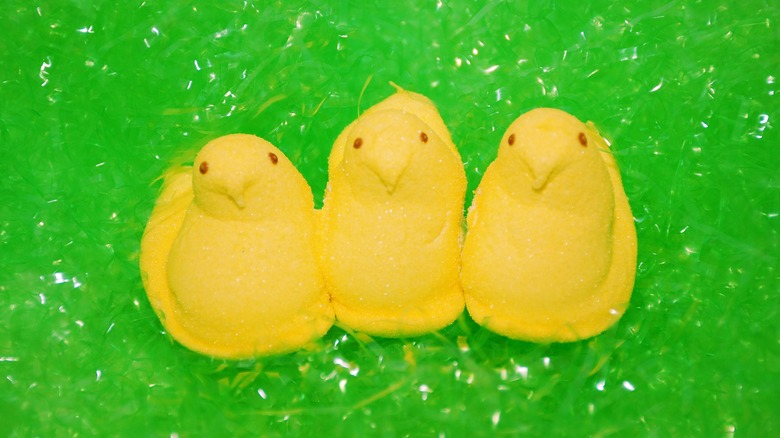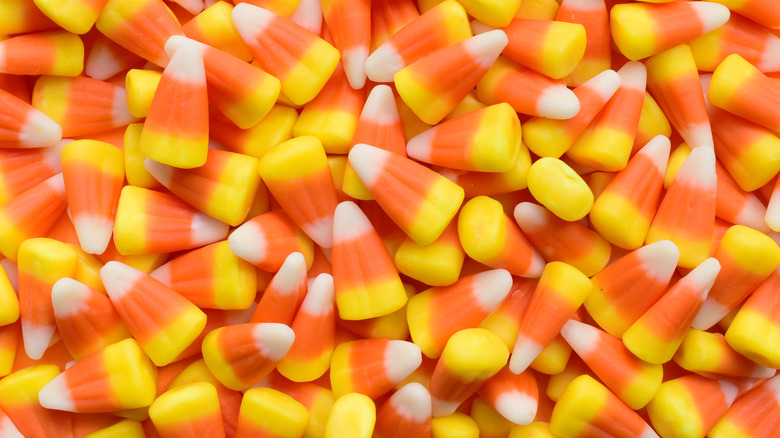Do Peeps Really Contain Carcinogens?
It turns out Peeps are even more disturbing than you thought. If you were laboring under the impression that Peeps were the innocuous type of nightmare fuel, with their weird, floppy elephant seal beaks and cold black eyes that stare deep into your soul as you go in for a bite, you were sadly mistaken.
A petition launched by Consumer Reports in April 2023 called attention to the fact that pink and purple varieties of Peeps are colored with Red Dye No. 3. That shouldn't come as news to anyone, since Red #3 is clearly listed among the Peeps' ingredients, but the petition raised alarms amongst many who were unaware of the implications of this additive. Red Dye No. 3 shows up in hundreds of candies, not just Peeps, and yet it has been banned in other industries, including cosmetics and medicine. The reason? Multiple studies have linked Red Dye No. 3 to cancer.
What is Red Dye No. 3?
"Red Dye No. 3" is such a vague name that it fails to tell you anything whatsoever about what the stuff is actually made out of. Of course, if product labels did state the specificities of this colorant, they probably wouldn't sell much candy. Red Dye No. 3 is technically known as erythrosine, and it is derived from petroleum, otherwise known as crude oil. In the early 1980s, a scientific study was done wherein 70 rats were fed massive amounts of Red Dye No. 3, equalling four percent of their lifetime diets, and 15 of these rats developed thyroid tumors (they also turned pink). Since then, further research has backed up the link to cancer, and identified many more food dyes, including Red 40, Yellow 5, and Yellow 6, as potential carcinogens.
The research of the 1980s started a wave of backlash against the use of Red Dye No. 3 in consumer products, leading the Food and Drug Administration to take action. In 1990, the FDA banned the use of Red Dye No. 3 in cosmetics and externally-applied medications. In the same year, the agency announced that it would pursue measures to ban the dye in food. More than three decades later, however, those measures have yet to be taken. Meanwhile, further scientific studies have shown Red Dye No. 3 to have neurobehavioral effects on children, including hyperactivity. This was observed in children who had as little as one milligram of the dye per day.
Peeps aren't the only sweet treat that contain carcinogenic dyes
Seizing the annual Easter Peeps rush as a chance to call attention to the risks of Red Dye No. 3 in foods, Consumer Reports petitioned the FDA to ban the colorant, a proposal the agency's own rules support. In 1958, a provision known as the Delaney Clause was added to the United States' national food laws, stating that any product shown to be capable of causing cancer in either human or animal trials could not be approved for use in any foods. However, Red Dye No. 3 had already been approved many decades before that, in 1907, so it would now fall upon the FDA to issue a ban. The agency issued a statement to the press assuring that it would review the Consumer Reports petition, but as of the time of this writing, there have been no further updates.
Although Peeps became the focal point of the Consumer Reports push to ban Red Dye No. 3, the problem extends far beyond that one product. Data compiled by the Environmental Working Group shows that Red Dye No. 3 appears in nearly 3,000 food products. Just Born Quality Confections, the company behind Peeps, has been flagged for having it in nine of their products, including Hot Tamales candy. The dye also shows up in candy corn, gumdrops, peppermints, and those candy hearts that we all keep buying for Valentines Day (despite having the taste and texture of sidewalk chalk).


